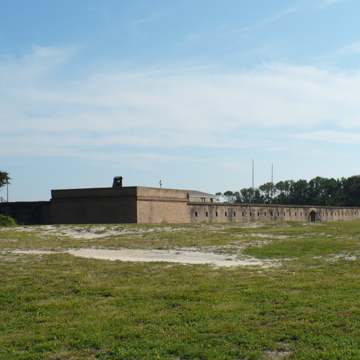Somewhere in the vicinity of today’s Fort Gaines, French colonists built a wooden fort along the sandy, ever-shifting shoreline of Dauphin Island soon after 1700. But only when the Gulf region passed into American hands a century later was a more permanent defense work begun: one of the twin fortifications protecting the entrance to Mobile Bay. In fact, original plans called for the Dauphin Island fort to be identical to its counterpart, Fort Morgan, across Mobile Sound to the east.
Work began in 1819 but was aborted two years later because of foundation flooding at high tide. Federal reauthorization of the project was delayed until 1846, while actual work did not resume for a decade, this time to a revised plan prepared by General Joseph G. Totten of the Army Corps of Engineers—a plan that reflected more recent thinking in military defensive architecture. The new design retained the pentagonal form seen at Fort Morgan, but lowered the height of the curtain walls and reduced the size and prominence of the five corner artillery bastions.
Named for General Edmund Pendleton Gaines (1777–1849), a prominent figure in the early American period of the Gulf Coast, Fort Gaines was still incomplete in January 1861, when it was seized, along with neighboring Fort Morgan, by Alabama state militia. Confederate military engineer Daniel Ledbetter (formerly with the U.S. Corps of Engineers) pushed forward its completion during the first two years of the Civil War, only to see it fall to Union naval forces after the Battle of Mobile Bay in August 1864. Regarrisoned during the Spanish-American War after decades of post–Civil War neglect, the fort also saw the construction of three new concrete gun batteries between 1891 and 1901. During World War I an anti-aircraft gunnery school was established at Fort Gaines, and in World War II the facility was used by the U.S. Coast Guard as well as the Alabama National Guard. Increasingly obsolete as a military facility, the fort passed into the hands of the Alabama Department of Conservation, which, in turn, deeded it to the Dauphin Island Park and Beach Board.
An ongoing struggle against shoreline erosion, which persistently threatens its eastern face, has placed Fort Gaines on several official lists of endangered landmarks—state, national, and military. In 1976 Fort Gaines was listed on the National Register of Historic Places. Now open to the public, the fort preserves at the edge of its parade ground a two-story, galleried brick officers’ quarters, a blacksmith shop, and other structures surviving from the Civil War era.
References
Robinson, Willard B. “Military Architecture at Mobile Bay.” Journal of the Society of Architectural Historians30 (May 1970): 119-139.
Weaver, John R. A Legacy in Brick and Stone: American Coastal Defense Forts of the Third System, 1816-1867. McLean, VA: Redoubt Press, 2001.




















